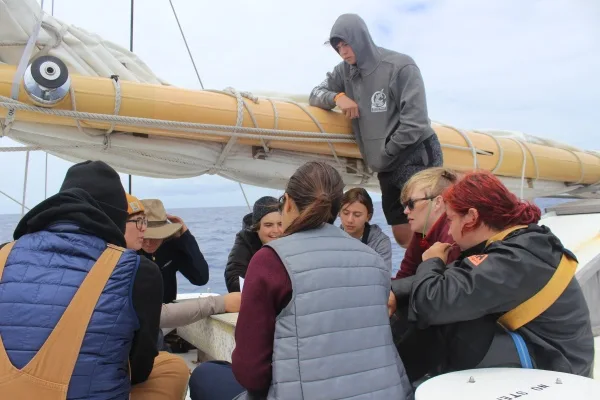Programs Blog
Entering the Home Stretch

Ryan McMullen, A Watch, University of Miami
Ship’s Log
Noon Position
35° 27.599’N 126° 34.00’W
Ship Heading
070°
Ship Speed
5 knots
Sail Paln
Storm Trys’l, Mainstays’l, Forestays’l, Jib, Jib Tops’l
Weather / Wind / Sail Plan
Wind- North by West at Beaufort Force of 4, Sea- 4-5 foot swells from the North, Cloud cover- 7/8ths primarily stratocumulus
Latest Neuston Tow Plastic Count
6
Welcome ladies and gentlemen to the sixth-to-last blog post of S-304! We officially entered the mighty California Current and the noticeable changes in weather and sea state are making sure everyone is well-aware. Foulie gear (rain gear) and extra layers are on full display as the air begins to chill and the constant Northerly wind nips at exposed skin with increasing sharpness. We now periodically encounter swells that are 6-8 feet which threatens to toss anything not secured in place including snacks, water bottles, and unsuspecting students.
As we look to regain our sea legs in these final days aboard the Robert C. Seamans, an even more omnipresent aspect of this trip must be balanced as well: Academics. In the past few days students have been working in small groups of 1-3 students on research projects covering many aspects of marine plastic debris in the North Pacific Subtropical Gyre (NPSG). Projects have ranged from rafting communities on large pieces of debris to sea birds to surface dwelling zooplankton. One group is even meticulously surveying species and age distributions of a type of pelagic insect that lives on the water surface. Most of the data for these projects is obtained through our usual day-to-day science proceedings but some groups put in extra effort to process their samples. Our data collection period officially closed since yesterday so all that’s left is to finalized our findings and crank out some good ole’ fashioned research papers.
My project has explored zooplankton abundance, biodiversity, and species richness in the NPSG. We have found similar spatial patterns for zooplankton density (a measure of abundance) and plastic density but less so for zooplankton biodiversity. My area of focus has been zooplankton species richness and how it varied across areas of high, medium, or low plastic concentrations. Thus far I have found that the total number of species observed decreased from 17 in low concentration areas to 9 species in higher concentration samples. Copepods, the most common taxa regardless of plastic density, comprised 78% to 86% of our total observed zooplankton. Within our research group, we still have to discuss and interpret our findings but our data suggests that marine microplastics may influence the abundance or diversity of zooplankton in an area by making conditions more/less ideal for certain species. My group mates and I will discuss these findings and construct a short presentation to the entire ship’s company tomorrow during class time.
With the end of the trip speeding toward us, bittersweet feelings weigh heavy on all students’ minds. Each day that passes means we are one day closer to saying our final goodbyes to the ship, each other, and the comforting bustle of life on deck. During our quiet moments some students talk of missing home, while others would give anything to stay at sea. Many of us fall at both extremes of this spectrum. Either way the end of this experience is inevitable and inescapable but the lessons, habits, and memories we have cultivated are sure to last with us far after we part ways.
As a final note I want to say hello to my family back home. Mom and Dad, I hope you guys have successfully found this blog and maybe even bookmarked it so you can check it easier (if not I can show you when I get home). Jack and Rachel, I hope your riding and baseball adventures have been going well and I am greatly looking forward to hearing any and all developments when I get to land. And to Michael, Shin, Skylar, and the rest of my friends back home I look forward to seeing you all and enjoying the final few weeks of summer before school starts.
Cheers,
Ryan McMullen, A Watch, University of Miami
Recent Posts from the Ships
- Ocean Classroom 2024-A collaborative high school program with Proctor Academy
- Collaborations and Long-term Commitments: SEA’s Caribbean Reef Program Sets a Course for Coastal Programs that Compliment Shipboard Experiences.
- Sea Education Association students prepare for life underway using state of the art nautical simulation from Wartsila Corporation.
- SEA Writer 2022, Magazines From the Summer SEA Quest Students
- Technology@SEA: Upgrades Allow Insight into Ocean Depths
Programs
- Gap Year
- Ocean Exploration
- High School
- Science at SEA
- SEA Expedition
- SEAScape
- Pre-College
- Proctor Ocean Classroom
- Protecting the Phoenix Islands
- SPICE
- Stanford@SEA
- Undergraduate
- Climate and Society
- Climate Change and Coastal Resilience
- Coral Reef Conservation
- Marine Biodiversity and Conservation
- MBL
- Ocean Exploration: Plastics
- Ocean Policy: Marine Protected Areas
- Oceans and Climate
- Pacific Reef Expedition
- The Global Ocean: Hawai'i
- The Global Ocean: New Zealand